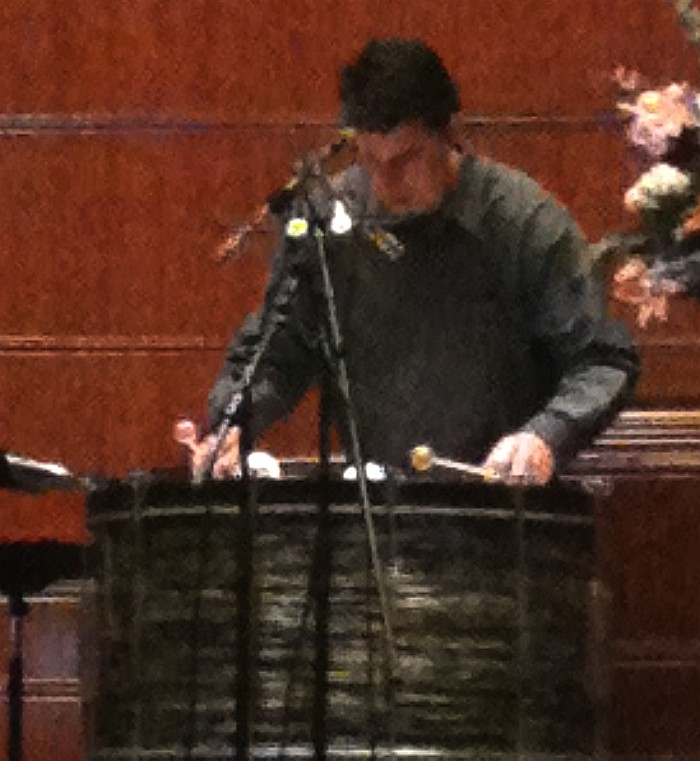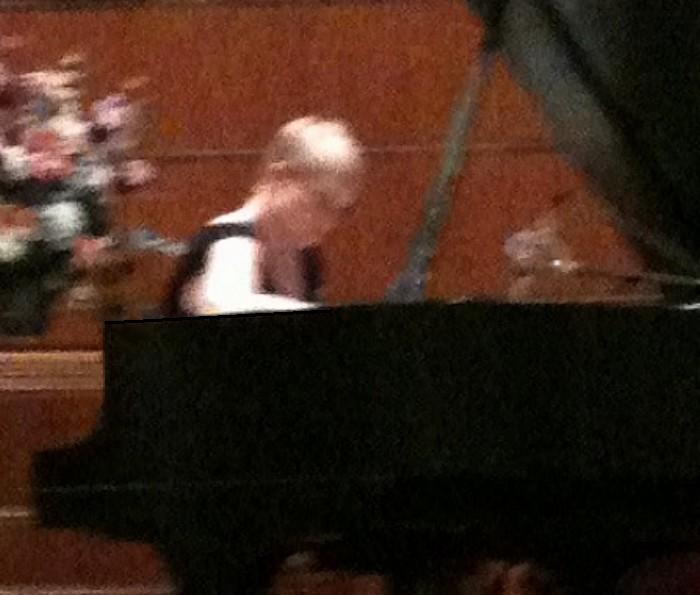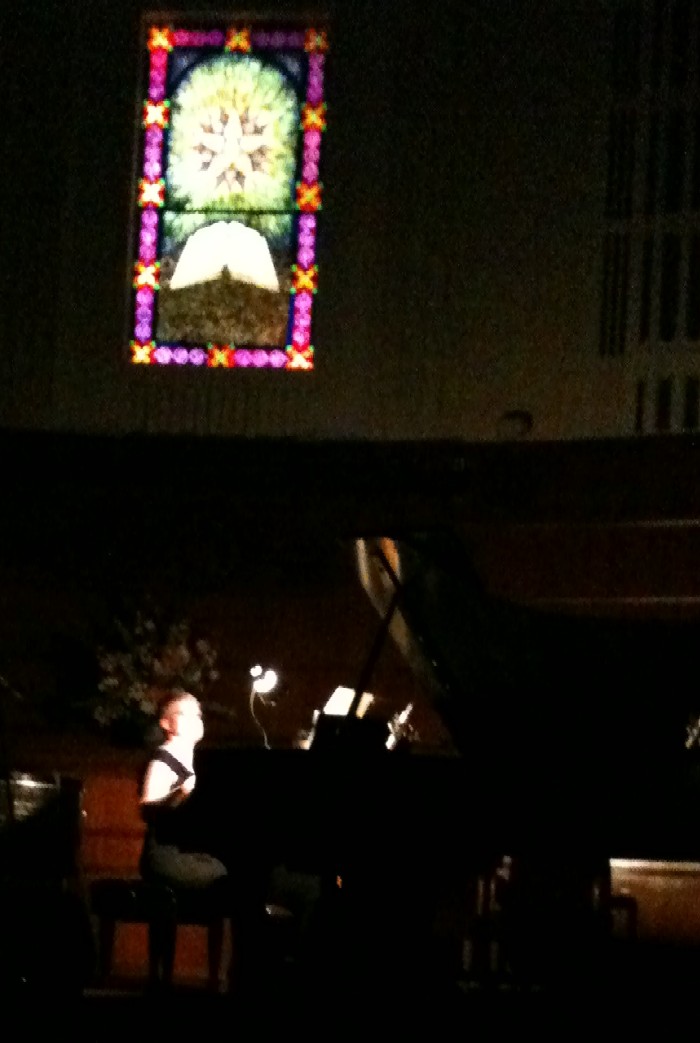 M any things to be enthused about last night, regarding Kari Johnson’s and Robert Burke’s KCeMA performance at Unity Temple.
M any things to be enthused about last night, regarding Kari Johnson’s and Robert Burke’s KCeMA performance at Unity Temple. - Christopher Biggs – The Ends of Histories (piano, electronics, and video, 10-min)
- Peter Swendsen – Nothing that is not there and the Nothing that is (instrumented bass drum and electronics, 8.5-min)
- Jeff Herriott – Velvet Sink (piano and electronics, 13-min)
- João Pedro Oliveira – Liquid Bars (vibraphone and electronics, 12-min)
- Scott Blasco – Queen of Heaven (piano and electronics, 23-min)
T he materials represent the following conceptions of the end of history: (1) a polarized religious End Time whereby everyone either ascends into a Pleasant World or descends into Fire—a prophetic, spiritual, transcendent End that has appeared in many forms throughout history and is currently represented by the idea that there will be some kind of cataclysm at the end of the Mayan calendar in 2012; (2) a sociopolitical End in which capitalist democracy supplants all other ideologies...; and (3) ‘scientific’ Ends... mass-extinctions.”P eter Swendsen’s ‘Nothing is not there and the Nothing that is’ for miked/instrumented bass drum and electronics draws its inspiration from violent forces of wind and weather. Forces of Nature are the architects of the sonic space and textures, and humans are compulsory respondents to natural events that are not of their choosing. The majority of the piece consists of canticle-like ‘verse-and-responsory’ segments, each about one minute in length. The human percussionist (Robert Burke) is entrained in Nature’s mesh (electronics, plus waveforms captured by mics—his own playing, digitally processed, delayed, pitch-bent, filtered, and replayed through monitors adjacent to him on-stage). The piece is written in such a way that the performer becomes progressively more mindful of the sonic consequences of each gesture, each mallet stroke, for what the future will become—and we in the audience experience this sense of the long-term impact that we have, on each other, on other species, and on the planet as a whole. Burke’s finesse with extended mallet techniques—including inducing aeroelastic drum-head vibrations with his hypothenar eminence and including wiping a stick fitted with a red silastic scrubber on the drum-head to evoke wild-animal growls and anguished roaring—were ‘Never-heard-anything-like-that-before!’ breathtaking.
— Christopher Biggs, composer.
A long the coast, this collision is a constant negotiation: the land and sea changing back and forth; the clouds that hover near the shoreline. In the interior, however, wind and weather do not negotiate.”J oão Pedro Oliveira’s ‘Liquid Bars’ delivers sonic textures that marry live marimba/vibraphone with the electronically-processed signals from two large dynamic ribbon mics positioned at approximately mid-resonator-tube height on the left side and right side of the instrument. The electronically-processed sounds mutate spontaneously under software control, modulated by the mallet strikes. The increasingly complex polyphonies and polyrhythms are fascinating and unnerving—almost like interviewing a person whose acute psychiatric problems have landed the person in your Emergency Room in the wee hours of a Saturday night. The notion of ‘self’ is called into question, not only who the self or ‘selves’ are—the one(s) in front of you—but also whether the whole assumption that ‘who’ any of us are is stable and ascertainable is faulty. The composition has ketamine-like psychotropic properties. Gee, should FDA and DEA regulate this music as a Schedule II pharmaceutical? Powerful! Robert Burke’s 4-mallet technique is superb...
— Peter Swendsen, composer.

L et us imagine a Marimba who can produce sound... Let us imagine that the Performer and the Marimba would each have the possibility of dividing themselves into two or more instruments and performers—and imagine that all of these play against each other.”J eff Herriott’s ‘Velvet Sink’ is a piece that explores the possibilities of the piano through both extended performance techniques and the use of digital audio. I worry that technical obsolescence tends to make works like these short-lived. Several works realized on the IRCAM’s realtime audio processor 4X, for example, can no longer be performed, because the equipment and operating-system become obsolete so fast and cannot readily be ‘refactored’ and ported to new configurations that can render the same effects as the old ones. There are maintenance problems even with well-structured software. Pieces for ‘tape’ survive: the process of recording will always be ported to more recent technologies, such as CDs, DVDs, and hard disks. Here, though, Herriott’s Max/MSP scripts and Peak and ProTools elements are fairly portable and are likely to withstand the technology changes of this decade and the next. Kari Johnson gives tactile, delicate treatments of the keyboard passages. Repetitive eighth-note patterns, very insistent, have undulating up-down microtonal bends applied to them, until the patterns feel like waves, a gentle-swell aquatic envelope—the sonic surface is a kind of ‘minimalism-built-out-of-complexity’, sort of oxymoronic jumbo-shrimp. Then she stands up, reaches into the piano and begins plucking strings with fingertips and fingernails; hammering piano strings with percussion mallets; modifying the placements of rubber erasers between strings, prepared-piano-style—at times music-box-like, at times chime-like.
— João Pedro Oliveira, composer.

S amples were recorded using both a baby grand and an out-of-tune piano-harp from a destroyed upright piano. Some of these sound snippets were then processed and patched to generate longer sound files that were, in turn, reconfigured with ProTools. Others, notably the plucked gestures in the third movement, sound in performance much as they did during the recording. Ultimately, a unique Max/MSP patch is used in performance to control the playback of the recorded material.”S cott Blasco’s (b'79) Queen of Heaven, composed for Ms. Johnson and premiered last night, consists of five movements, each conceived as [a religious—] icon, concerning itself with a single idea, turning it over and over, meditating on it from different angles. ‘Queen of Heaven’ is dedicated to the Blessed Virgin Mary, “a source of comfort and inspiration to Christians from the earliest years of their history,” in the composer’s words. Blasco’s composition, informed by his Master’s degree in Theology from Fuller Theological Seminary and degree in Composition and Music Theory from Calvin College, is a highly personal exegesis. The angels’ ‘greeting’ the Mother of God in the first movement conveys more of a confrontation—as in Awed and Struck Dumb—than a ‘greeting’. Sonority and terror appear linked in other of the movements as well, enough to cause most to have second-thoughts about the appeal of the Pearly Gates.
— Jeff Herriott, composer.
W hen I write music, I’m not writing it ‘for me’ per se. I see it as holding out an olive branch to my audience, and offering praise by mirroring the Creator.”K ari Johnson is a DMA student at UMKC Conservatory where she studies with John McIntyre. She holds bachelor’s degrees in Piano Performance and Piano Pedagogy from the University of Central Missouri, a master’s degree in Piano Performance from Bowling Green State University, and a master’s degree in Piano Pedagogy from the University of Illinois Urbana-Champaign. Ms. Johnson has won or placed in competitions throughout the Midwest, including the MTNA Steinway Young Artist Competitions in Missouri and Illinois and the Venetia Hall Concerto Competition. An active performer of new music and chamber music, Ms. Johnson’s recent performances include collaborative concerts at the University of Central Missouri and Pittsburg State University, UMKC’s “Carter and Messiaen at 100” festival, and the CMS Great Plains Chapter 2009 Regional Conference. In the coming year she will perform at the 2010 UCM New Music Festival and the 2010 SEAMUS National Conference.
— Scott Blasco, composer.
R obert Burke is also a DMA student at UMKC Conservatory. He has enjoyed an eclectic carrier performing, studying and teaching throughout Canada, The United States, Japan and Europe. He is originally from Alberta, Canada although for the last decade has hailed New Orleans as home. A strong advocate of new music, Mr. Burke has commissioned and performed countless solo percussion works in recital and held member ship in New Works Calgary, Syncronia (St. Louis) and Conundrum New Music Ensemble. He has also been a regular member of the Edmonton Symphony Orchestra, The Calgary Philharmonic and The Louisianna Philharmonic. As a drumset player, Mr. Burke has performed and toured with a remarkable number of recording artists in clubs and festivals throughout the United States and Europe, including Brian Lee, Johnny Sansone, Preston Hubbard, Frankie Ford, Cyril Neville, Allen Toussaint, Irma Thomas, Peter Nero, Marvin Hamlish, and Robert Goulet. He holds degrees from University of Alberta and the University of Calgary and has served on the faculty of the University of Calgary, Mount Royal College, the University of Missouri-Columbia and Central Methodist College.
- Kansas City Electronic Music Alliance (KCeMA)
- Kari Johnson page at UMKC Conservatory
- Robert Burke contact
- Scott Blasco website
- João Pedro Oliveira website
- Christopher Biggs website
- Jeff Herriott website
- Peter Swendsen website
- Musser M75-Century vibraphone
- Musser M250-ConcertGrand marimba

No comments:
Post a Comment